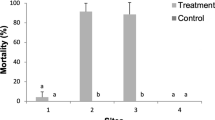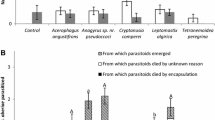Abstract
The effectiveness ofTrichogramma dendrolimi, Trichogramma embryophagum, Trichogramma sp. strain 45 andTrichogramma sp. strain 48 to control the codling mothCydia pomonella L. and the summer fruit tortrix mothAdoxophyes orana F.R. was tested in 4 field trials (1984–1986). Four to sixTrichogramma treatments (depending on the temperature) each at 400 (pillar trees) to 9,000 (round tops) parasites per tree were carried out between June and August to insure the continuous presence ofTrichogramma in the plots. The monitoring was done by examining 3,000 to 10,000 apple fruits per plot.
T. dendrolimi reduced the damage ofC. pomonella by 61.35%, ofA. orana by 72.85%.T. embryophagum reduced the damage ofC. pomonella by 50.06%, ofA. orana by 50.8%.Trichogramma strain 45 reduced the damage ofC. pomonella by 41.6% and ofA. orana by 87.9%,Trichogramma strain 48 by 57.2% and 51.2% respectively.
The reduction of 67.1% in the number of apple fruits damaged byC. pomonella andA. orana obtained by the inundative releases ofT. dendrolimi in these experiments is considered economically and the use of this species in practice is recommended.
Zusammenfassung
Die Bekämpfung des ApfelwicklersCydia pomonella L. sowie des ApfelschalenwicklersAdoxophyes orana F.R. durch Freilassungen vonTrichogramma dendrolimi, T. embryophagum. T. sp. Stamm 45 undT. sp. Stamm 48 wurde zwischen 1984 und 1986 in vier Feldversuchen erprobt. Bei vier bis sechsTrichogramma-Behandlungen zwischen Juni und August (in Abhängigkeit von der Temperatur) gelangten pro Baum jeweils ca. 400 Parasiten bei Pillarbäumen und ca. 9 000 Parasiten bei Rundkronen zum Einsatz. Auf diese Weise waren in den Parzellen ständig aktive Parasiten vorhanden. Bei der Auswertung wurden 3 000 bis 10 000 Früchte pro Parzelle untersucht.
T. dendrolimi reduzierte den Befall vonC. pomonella um 61,35%; den Befall vonA. orana um 72,85%.T. embryophagum verminderte den Befall vonC. pomonella um 50.06% sowie den Schaden durchA. orana um 50,80%.Trichogramma Stamm 45 führte zu Befallsverminderungen beiC. pomonella von 41,6% und beiA. orana von 87,9%.Trichogramma Stamm 48 konnte den Befall beiC. pomonella um 57,2% und den vonA. orana um 51,2% verringern. Durch die Freilassungen vonT. dendrolimi konnte in diesen Feldversuchen der Befall durchC. pomonella undA. orana um 67,1% reduziert werden. Diese Ergebnisse sind wirtschaftlich von Interesse. Die praktische Anwendung vonT. dendrolimi gegen Wicklerarten im Apfelanbau wird empfohlen.
Résumé
L'efficacité deTrichogramma dendrolimi, Trichogramma embryophagum, Trichogramma sp. souche 45 etTrichogramma sp. souche 48 pour lutter contre le CarpocapseCydia pomonella L. et la tordeuse des fruitsAdoxophyes orana F.R. a été expérimentée dans quatre essais de plein champ. Quatre à six traitements par Trichogrammes (dépendant de la température) à raison de 400 individus/arbre (au centre) à 9 000 parasites à la périphérie du faîte ont été réalisés entre juin et août afin d'assurer la présence continue deTrichogramma dans les parcelles. La surveillance a été réalisée par l'examen de 3 000 à 10 000 pommes par parcelle.
T. dendrolimi réduit les dégâts du Carpocapse de 61,35% et d'A. orana de 72,85%.T. embryophagum réduit les dégâts deC. pomonella de 50,06% et d'A. orana de 50,08%. La souche 45 deTrichogramma réduit les dégâts deC. pomonella de 41,6% et d'A. orana de 87,9%, la souche 48 deTrichogramma de 57,2% et de 51,2 respectivement.
La réduction de 67,1% du nombre de pommes endommagées parC. pomonella etA. orana obtenue par les lâchers inondatifs deT. dendrolimi dans ces expériences est considérée comme significative économiquement et l'emploi de cette espèce peut être recommandé dans la pratique.
Similar content being viewed by others
References
Flanders, S. E. — 1928. The mass production ofTrichogramma minutum Riley and observations on the natural and artificial parasitism of the codling moth eggs. —4th Int. Cong. Ent. Ithaca. N.Y., pp. 110–130.
Hassan, S. A. — 1983. Ergebnisse der Laborprüfung einer Reihe von Pflanzenschutzmitteln auf Eiparasiten der GattungTrichogramma [Hym.: Trichogrammatidae]. —Nachrichtenbl. Deut. Pflanzenschutzd., 35, 21–25.
Hassan, S. A. — 1984.Trichogramma News Nr. 2 (S. A. Hassan, ed.),Fed.Biol. Res. Cent. Agric. For., Braunschweig, 27 pp.
Hassan, S. A. — 1986.Trichogramma News Nr. 3 (S. A. Hassan, ed.),Fed. Biol. Res. Cent. Agric. For., Braunschweig, 30 pp.
Hassan, S. A. — 1988. Choice of suitableTrichogramma species to control the codling mothCydia pomonella L. and the summer fruit tortrix mothAdoxophyes orana F.R. [Lep.: Tortricidae] (in preparation).
Hassan, S. A. &Heil, M. — 1980. Bekämpfung des Maiszünslers mit einer einmaligen Freilassung des EiparasitenTrichogramma evanescens. —Nachrichtenbl. Deut. Pflanzenschutzd. (Braunschweig), 32, 97–99.
Hassan, S. A., Albert, R., Bigler, F., Blaisinger, P., Bogenschütz, H., Boller, E., Brun, J., Chiverton, P., Edwards, P., Englert, W. D., Huang, P., Inglesfield, C., Naton, E., Oomen, P. A., Overmeer, W. P. J., Rieckmann, W., Samsøe-Petersen, L., Stäubli, A., Tuset, J. J., Viggiani, G. &Vanwetswinkel, G., — 1987. Results of the third joint pesticide testing programme by the IOBC/WPRS-Working Group “Pesticides and Beneficial Organisms”. —Z. Angew. Entomol., 103, 92–107.
Hochmut, R. &Martinek, V. — 1963. Beitrag zur Kenntnis der mitteleuropäischen Arten und Rassen der GattungTrichogramma Westw. [Hym.: Trichogrammatidae]. —Z. Angew. Entomol., 52, 255–274.
Nettles, W. C. — 1934. The codling moth in South Carolina. —Bull. S. C. Agric. Exp. Stc., p. 30.
Pawar, A. D., Tuhan, N. C., Balasubramaniam, S. &Parry, M. — 1980. Biological control of codling moth in Ladakh. —Indian J. Plant Prot., VIII, 189–191.
Schütte, F. &Franz, J. M. — 1961. Untersuchungen zur Apfelwicklerbekämpfung (Carpocapsa pomonella L.) mit Hilfe vonTrichogramma embryophagum Hartig. —Entomophaga, 4, 237–247.
Sidirovnina, E. P. — 1936.Trichogramma in the gardens of Azerbaijan. In: Summary of the scientific work of the Inst. of Plant Protect. the year 1936, Part III (Leningrad), pp. 60–63.
Voegele, J., Martouret, D. &Goujet, R. — 1978. Preliminary experiments usingTrichogramma sp. against the codling moth in apple orchards, in the parisian region. —Mitt. Biol. Bundesanst., 180, 88–90.
Author information
Authors and Affiliations
Rights and permissions
About this article
Cite this article
Hassan, S.A., Kohler, E. & Rost, W.M. Mass production and utilization ofTrichogramma: 10. Control of the codling mothCydia pomonella and the summer fruit tortrix mothAdoxophyes orana [Lep.: Tortricidae]. Entomophaga 33, 413–420 (1988). https://doi.org/10.1007/BF02373177
Received:
Accepted:
Issue Date:
DOI: https://doi.org/10.1007/BF02373177




